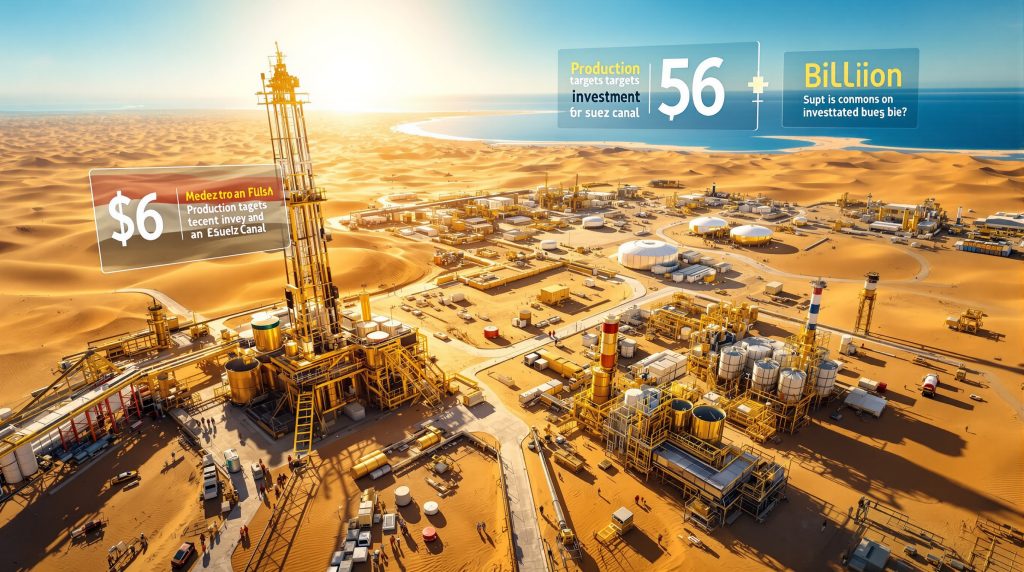How Is Egypt Transforming Its Oil Sector With $6 Billion Investment?
Egypt is making a strategic pivot in its hydrocarbon sector through a comprehensive $6 billion investment focused on crude oil exploration and production. This bold initiative aims to bolster the country's energy security, stimulate economic development, and cement Egypt's position as a key energy hub in North Africa and the Eastern Mediterranean region.
The investment strategy encompasses multiple components including extensive drilling programs, field development projects, infrastructure modernization, and strategic international partnerships designed to maximize Egypt's petroleum resources amid evolving global energy dynamics.
Key Investment Objectives
- Increase domestic crude oil production capacity
- Reduce dependence on imported energy products
- Generate substantial employment in the energy sector
- Attract foreign direct investment in upstream activities
- Develop untapped fields in strategic regions
- Implement cutting-edge exploration technologies
What Regions Will Benefit From Egypt's Oil Investment Strategy?
The $6 billion investment plan strategically targets several high-potential petroleum basins across Egypt, with resources allocated based on geological prospects and existing infrastructure accessibility.
Mediterranean Basin Development
The Mediterranean region represents a cornerstone of Egypt's petroleum strategy, with significant capital directed toward both mature fields and frontier exploration areas. According to the Egyptian Ministry of Petroleum, seven undeveloped fields in this region have been identified for substantial development funding.
These Mediterranean assets are being organized into development clusters to optimize infrastructure utilization, reduce overall costs, and accelerate production timelines. The clustering approach strategically groups geologically similar fields such as Aten, Merit, and Rahmat in one cluster, while Notus, Salamat, Satis, and Salmon form another development group.
According to the U.S. Energy Information Administration's "Egypt Country Analysis," the Mediterranean region contains estimated reserves of approximately 1.8 billion barrels of oil equivalent and currently accounts for roughly 20% of Egypt's oil production.
Western Desert Expansion
The Western Desert continues to be Egypt's most prolific onshore oil-producing region, responsible for approximately 60% of the country's crude oil production, and will receive a substantial portion of the $6 billion investment. Plans include:
- Drilling over 40 exploratory wells in 2026
- Implementing enhanced oil recovery techniques in mature fields
- Developing six new exploration blocks recently offered for bidding
- Expanding pipeline infrastructure to reduce transportation costs
Gulf of Suez Revitalization
The historic Gulf of Suez basin, Egypt's traditional oil-producing heartland since the 1960s, is targeted for revitalization through:
- Application of advanced seismic imaging to identify bypassed reserves
- Workover operations on existing wells to enhance recovery
- Development of smaller satellite fields previously deemed uneconomical
- Infrastructure modernization to reduce operational costs
The Gulf of Suez currently accounts for approximately 20-25% of Egypt's crude oil production but faces natural decline rates that require intervention.
How Will Egypt Execute Its Ambitious Drilling Program?
A cornerstone of Egypt's $6 billion investment is an aggressive drilling campaign designed to rapidly expand reserves and production capacity across the country's petroleum basins.
2026 Drilling Targets
The immediate focus includes drilling over 100 oil and gas wells in 2026 alone, representing one of the most ambitious drilling programs in Egypt's recent history. According to Baker Hughes international rig count data, Egypt drilled approximately 85 wells (oil and gas combined) in 2023, making the 2026 target a significant increase. These planned wells will be distributed across:
- 45 wells in the Western Desert
- 32 wells in the Mediterranean region
- 25 wells in the Gulf of Suez
- Additional exploratory wells in frontier basins
Long-Term Exploration Strategy
Looking beyond 2026, Egypt has outlined plans to drill approximately 480 exploratory wells by 2030, with nearly $5.7 billion allocated specifically for exploration activities. This sustained drilling program aims to:
- Replace declining production from mature fields
- Discover new petroleum systems in underexplored areas
- Maintain production stability over the next decade
- Build reserves for long-term energy security
Technology Integration
The drilling program will leverage advanced technologies to improve success rates and operational efficiency:
- 3D and 4D seismic imaging for better subsurface visualization
- Machine learning algorithms for prospect identification
- Horizontal and multilateral drilling techniques
- Real-time drilling optimization systems
According to Schlumberger technical publications, 4D seismic (time-lapse 3D) allows operators to track reservoir changes during production and can improve field development planning while increasing ultimate recovery by 5-10%. Similarly, innovative drilling practices and horizontal wells can increase reservoir contact by 3-10 times compared to vertical wells, particularly effective in the thin pay zones common in Egypt's mature fields, according to Society of Petroleum Engineers technical papers.
What International Partnerships Are Driving Egypt's Oil Investment?
Egypt's petroleum sector transformation relies heavily on collaboration with international energy companies, bringing technical expertise and financial resources to the country's oil development efforts.
Recent Investment Agreements
Several significant deals have recently been finalized to support Egypt's oil sector growth:
| Company | Investment Value | Focus Area | Project Scope |
|---|---|---|---|
| Shell | $120 million | Mediterranean | Exploration and field development |
| Petronas | $95 million | Gulf of Suez | Enhanced oil recovery |
| Cheiron Energy | $125 million | Western Desert | New field development |
| Dragon Oil (UAE) | Undisclosed | North Safa Field | Production expansion |
Shell has been operating in Egypt since 1911 and currently produces approximately 12% of Egypt's total oil and gas production, according to Shell Egypt's country reports. Meanwhile, Cheiron has emerged as one of Egypt's largest independent oil and gas producers, operating multiple concessions in the Western Desert and Gulf of Suez with production of approximately 75,000 barrels of oil equivalent per day.
These agreements are part of a broader trend, with foreign investment in Egypt's petroleum sector expected to reach approximately $4 billion in the 2024-2025 fiscal year alone.
Investment Climate Improvements
To attract and retain international partners, Egypt has implemented several key reforms:
- Resolution of overdue payments to international oil companies
- Implementation of the Egypt Upstream Gateway digital platform
- Streamlined regulatory approvals for exploration activities
- More flexible production-sharing contract terms
- Digital data access for exploration partners
According to the Atlantic Council's Middle East Energy Forum, Egypt has made significant progress in improving its investment climate for international oil companies, particularly through resolving historical payment arrears that had reached approximately $6 billion in 2016. The country has largely cleared these obligations, substantially improving its attractiveness to foreign investors.
How Is Egypt Structuring Its Bidding Rounds For Maximum Impact?
The Ministry of Petroleum and Mineral Resources has designed a strategic bidding process to optimize investment allocation and accelerate field development across Egypt's hydrocarbon basins.
Current Bidding Opportunities
Egypt is currently conducting a bidding round through the Egypt Upstream Gateway (EUG) that includes:
- Seven undeveloped fields in the Mediterranean
- Six exploration areas in the Western Desert and Gulf of Suez
This bidding round represents a significant opportunity for international companies to participate in Egypt's oil sector expansion.
Cluster-Based Development Approach
A notable innovation in Egypt's bidding strategy is the cluster-based development model, which:
- Groups geologically related fields for integrated development
- Reduces infrastructure duplication and capital requirements
- Accelerates time-to-market for new production
- Improves economic viability of smaller discoveries
According to Wood Mackenzie research, cluster developments can reduce per-barrel development costs by 15-30% compared to standalone field developments through shared infrastructure and economies of scale.
Transparent Digital Process
The bidding process has been modernized through the Egypt Upstream Gateway platform, which provides:
- Digital access to geological and production data
- Standardized evaluation criteria
- Transparent bid submission and evaluation
- Real-time updates on bidding status
Launched by the Egyptian Ministry of Petroleum in 2021, the EUG platform provides international companies access to geological data, seismic surveys, and production information for available exploration blocks. According to Rystad Energy, digital platforms reduce bid preparation time by approximately 30% and increase participation by smaller companies that previously found data access prohibitively expensive.
What Production Targets Has Egypt Set For Its Oil Sector?
Egypt has established ambitious but realistic production targets as part of its $6 billion investment strategy, designed to reverse recent production declines and establish sustainable growth.
Short-Term Production Goals
By the end of 2026, Egypt aims to:
- Increase crude oil production by approximately 15-20% from current levels
- Stabilize production from mature fields through enhanced recovery
- Bring at least five new development projects online
- Reduce production decline rates in aging fields to below 5% annually
Egypt's crude oil production declined from approximately 628,000 bpd in 2016 to 558,000 bpd in 2023, representing an average annual decline of approximately 1.6%, according to OPEC's Annual Statistical Bulletin. Recent US oil production trends show similar challenges in maintaining output levels without significant investment.
Long-Term Production Outlook
The broader vision extends to 2030, with targets including:
- Sustained production growth averaging 3-5% annually
- Development of at least 15 new oil fields
- Replacement ratio of reserves exceeding 100%
- Reduction in production costs through operational efficiencies
Production Optimization Strategy
Beyond new drilling, Egypt is focusing on maximizing recovery from existing assets through:
- Water and gas injection programs in mature fields
- Artificial lift optimization in declining wells
- Digital oilfield technologies for real-time production monitoring
- Reduction in non-productive time through predictive maintenance
According to technical studies from the Society of Petroleum Engineers, Egypt's mature fields have average recovery factors of 25-35%, below the global average of 35-45%, indicating significant potential for improved recovery through enhanced oil recovery techniques.
How Will This Investment Impact Egypt's Energy Security?
The $6 billion crude oil investment represents a critical component of Egypt's broader energy security strategy, addressing multiple national priorities in an increasingly complex global energy landscape.
Reducing Import Dependence
Despite being an oil producer, Egypt has faced increasing reliance on imported petroleum products. In 2023, Egypt imported approximately 176,000 bpd of petroleum products while exporting minimal crude oil, according to the U.S. Energy Information Administration. The investment aims to:
- Narrow the gap between domestic production and consumption
- Reduce foreign exchange expenditure on energy imports
- Improve the country's trade balance
- Provide a buffer against international price volatility
Ensuring Stable Fuel Supplies
A key objective is maintaining reliable fuel supplies for:
- Power generation facilities
- Transportation sector needs
- Industrial operations
- Agricultural requirements
Strategic Reserve Development
Part of the investment will support:
- Expansion of crude oil storage capacity
- Development of strategic petroleum reserves
- Modernization of distribution infrastructure
- Emergency response capabilities
According to the International Energy Agency guidelines, countries should maintain emergency stocks equivalent to at least 90 days of net imports for energy security purposes.
What Economic Benefits Will Egypt's Oil Investment Generate?
The $6 billion investment is expected to deliver substantial economic returns beyond direct energy production, creating a multiplier effect throughout the Egyptian economy.
Employment Creation
The investment program is projected to generate:
- Thousands of direct jobs in drilling, production, and field services
- Additional indirect employment in supporting industries
- Skills development opportunities for the Egyptian workforce
- Enhanced technical capabilities through knowledge transfer
The Egyptian petroleum sector directly employs approximately 45,000-50,000 workers and supports an estimated 150,000-200,000 indirect jobs in services, supply chain, and related industries, according to sector reports from the Egyptian Ministry of Petroleum and Mineral Resources.
Supply Chain Development
Local content requirements will stimulate:
- Growth in domestic oilfield service companies
- Manufacturing opportunities for equipment and components
- Logistics and transportation service expansion
- Technical consulting and engineering services
According to World Bank analysis, well-designed local content programs can increase domestic employment while maintaining project efficiency, with requirements in the region typically ranging from 30-70% depending on project phase and capability development.
Government Revenue Enhancement
Successful implementation will boost fiscal resources through:
- Increased royalties and production shares
- Tax revenue from expanded operations
- Reduced subsidy requirements for imported fuels
- Foreign exchange savings
Petroleum revenues currently constitute approximately 10-15% of Egypt's total government revenues, including royalties, profit shares, taxes, and revenues from state-owned companies, according to the Egyptian Ministry of Finance's annual budget documents.
How Does This Investment Fit Into Egypt's Regional Energy Hub Ambitions?
The $6 billion crude oil investment complements Egypt's broader strategy to become the preeminent energy hub in the Eastern Mediterranean and North Africa, leveraging its strategic geographic position and existing infrastructure.
Infrastructure Integration
Oil development will leverage and enhance Egypt's strategic energy infrastructure:
- Suez Canal petroleum transportation capabilities
- SUMED pipeline system connecting the Red Sea and Mediterranean
- Refining and processing facilities
- Export terminals and storage facilities
The Suez-Mediterranean (SUMED) Pipeline has capacity to transport 2.34 million barrels per day of crude oil from the Red Sea to the Mediterranean, bypassing the Suez Canal. In 2023, the pipeline transported approximately 1.0-1.2 million bpd, according to the U.S. Energy Information Administration. Additionally, approximately 2.3-2.8 million barrels per day of crude oil and petroleum products transit the Suez Canal annually, making it one of the world's critical oil transit chokepoints.
Regional Cooperation Enhancement
The investment strengthens Egypt's position in regional energy diplomacy:
- Collaboration with Eastern Mediterranean Gas Forum partners
- Cross-border field development opportunities
- Shared infrastructure development with neighboring countries
- Joint marketing initiatives for petroleum exports
Established in 2020, the East Mediterranean Gas Forum (EMGF) includes Egypt, Cyprus, Greece, Israel, Italy, Jordan, and Palestine as full members, with France and the United States as observers. The forum aims to create a regional gas market and coordinate infrastructure development.
Energy Transition Considerations
While focusing on oil development, the investment plan acknowledges energy transition realities:
- Prioritization of lower-carbon intensity production methods
- Methane emissions reduction initiatives
- Integration with renewable energy development plans
- Research into carbon capture utilization and storage opportunities
According to the Global CCS Institute, several oil-producing countries are exploring CCUS integration with EOR operations, where CO2 injection both enhances oil recovery and provides permanent geological storage. In Egypt's context, high-CO2 natural gas fields in the Western Desert could provide CO2 sources for EOR.
What Challenges Must Egypt Overcome To Maximize Investment Returns?
Despite its promising outlook, Egypt's $6 billion oil investment faces several significant challenges that require strategic management to ensure projected returns are achieved.
Technical Challenges
The development program must address:
- Increasing geological complexity in mature basins
- High water cut in aging fields
- Challenging reservoir conditions in some new prospects
- Infrastructure limitations in remote areas
Egypt's major producing fields, particularly in the Gulf of Suez and Western Desert, have been in production for 30-60 years. According to technical analysis from the Society of Petroleum Engineers, mature fields in the region typically exhibit water cuts (water production as percentage of total liquid) of 70-90% in later stages of production.
Market Uncertainties
External factors that could impact investment returns include:
- Global oil price volatility
- Changing patterns of international demand
- Competition from other producing regions
- Energy transition pressures on fossil fuel investments
Brent crude oil prices ranged from approximately $69/bbl to $97/bbl in 2023, demonstrating continued price volatility that affects investment returns. Additionally, according to the International Energy Agency's World Energy Outlook, global oil demand growth is expected to slow significantly after 2025 due to electric vehicle adoption, efficiency improvements, and energy transition policies in major consuming countries. The possibility of an oil price crash or oil price stagnation factors could significantly impact investment returns.
Implementation Risks
Operational considerations include:
- Potential for project delays and cost overruns
- Supply chain constraints for equipment and services
- Skilled workforce availability
- Regulatory and administrative bottlenecks
What Is The Timeline For Egypt's Oil Investment Implementation?
The $6 billion investment program follows a phased approach designed to balance immediate production needs with long-term development goals.
Phase 1 (2025-2026)
The initial implementation phase focuses on:
- Launching the first wave of drilling activities (100+ wells)
- Completing bidding rounds for undeveloped fields
- Initiating development of highest-priority assets
- Implementing quick-win production enhancement projects
Phase 2 (2027-2028)
The middle implementation period will concentrate on:
- Accelerating development drilling in newly awarded blocks
- Expanding enhanced oil recovery projects in mature fields
- Completing major infrastructure upgrades
- Advancing exploration in frontier basins
Phase 3 (2029-2030)
The final phase will emphasize:
- Full development of discoveries made in earlier phases
- Optimization of field performance across the portfolio
- Integration of advanced technologies for production maximization
- Preparation for subsequent investment cycles
Egypt's Strategic Oil Future
Egypt's $6 billion investment in crude oil development represents a bold and comprehensive approach to revitalizing its petroleum sector. By focusing on strategic basins, implementing cluster-based development, fostering international partnerships, and embracing technological innovation, Egypt is positioning itself for sustainable growth in oil production.
The success of this investment will be measured not only in barrels produced but also in enhanced energy security, economic benefits, and regional influence. While challenges remain, Egypt's methodical approach to implementation provides a strong foundation for achieving its ambitious objectives.
As global energy markets continue to evolve, Egypt's balanced strategy—combining immediate production growth with longer-term sustainability considerations—offers a model for resource-rich nations navigating the complex intersection of energy security, economic development, and environmental responsibility.
FAQ: Egypt's $6 Billion Crude Oil Investment
Q: How will Egypt fund its $6 billion oil investment program?
A: Funding will come from a combination of government allocations, international oil company investments through production sharing agreements, development finance institutions, and commercial lending.
Q: Will this investment impact Egypt's commitments to renewable energy?
A: Egypt maintains that its oil sector investment complements rather than competes with its renewable energy goals, with petroleum revenues potentially supporting the transition to cleaner energy sources.
Q: How does this investment compare to Egypt's previous oil sector spending?
A: The $6 billion program represents one of the largest concentrated investments in Egypt's oil sector in recent decades, approximately doubling the average annual investment rate of the past five years.
Q: What role will technology play in Egypt's oil development strategy?
A: Advanced technologies—including AI-assisted exploration, digital oilfield management, enhanced recovery techniques, and emissions monitoring—are central to maximizing returns from the investment.
Want to Capitalise on the Next Major Mineral Discovery?
Discover significant ASX mineral announcements in real-time with Discovery Alert's proprietary Discovery IQ model, which transforms complex mineral data into actionable investment insights. Visit the Discovery Alert discoveries page to understand how major mineral discoveries can lead to exceptional market returns and begin your 30-day free trial today.




